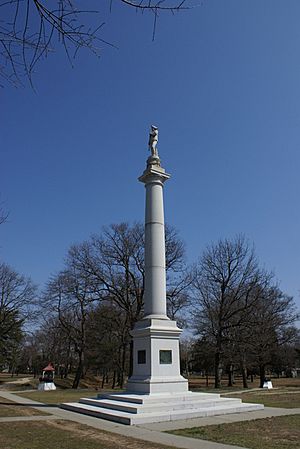Fort Mercer facts for kids
Quick facts for kids Fort Mercer |
|
|---|---|
| Red Bank, New Jersey | |

Monument in Fort Mercer, 2008
|
|
| Lua error in Module:Location_map at line 420: attempt to index field 'wikibase' (a nil value). | |
| Type | Earthwork |
| Site history | |
| Built | 1777 |
| Built by |
|
| In use | 1777–1781 |
| Materials | earth, logs |
|
Red Bank Battlefield
|
|
| Location | 100 Hessian Ave., National Park, NJ 08063 |
| NRHP reference No. | 72000796 |
| Significant dates | |
| Added to NRHP | October 31, 1972 |
| Designated NHL | November 28, 1972 |
| Battles/wars | American Revolutionary War |
| Garrison information | |
| Past commanders |
Christopher Greene |
Fort Mercer was an important fort built during the American Revolutionary War. It was made of earth and logs and stood on the New Jersey side of the Delaware River. The fort was designed by a Polish engineer named Thaddeus Kosciuszko. He worked under the orders of George Washington, who later became the first U.S. President.
Built in 1777, Fort Mercer's main job was to help block the way to Philadelphia, Pennsylvania. It worked together with Fort Mifflin, which was on the Pennsylvania side of the river. Fort Mercer was located in an area called Red Bank. This place is now part of the borough of National Park in Gloucester County, New Jersey. The fort was named after Brigadier General Hugh Mercer, a brave officer who died earlier that year. Today, the fort's site is a historical park called Red Bank Battlefield. You can find a monument and a museum there. The park also has cannons that were found at the fort or from British ships lost during the battle.
Why Fort Mercer Was Built
Fort Mercer was built to protect special underwater obstacles in the Delaware River. These obstacles were called chevaux de frise. They were sharp wooden spikes hidden underwater to stop enemy ships. Another fort, Fort Billingsport, was built further downriver to protect more of these obstacles.
Fort Mercer had strong earthen walls and a ditch around it. On top of the walls were sharp logs, forming a palisade. The fort was quite long, about 320 yards, and 50 yards wide. It had 14 cannons ready to fire. There were also strong corners called bastions on the land side. These bastions helped protect the fort from attacks.
A smaller defense area was located north of the main fort. However, this outer area was not guarded. Fort Mercer could hold up to 1,500 soldiers. But only about 600 were available to defend it. Most of these soldiers were from Rhode Island and part of the Continental Army. Their leader was Colonel Christopher Greene, also from Rhode Island. A French officer, Thomas Duplessis, helped make the fort even stronger. He had a wall built inside the fort on the river side. This made it easier for the small group of soldiers to defend.
The Battle of Red Bank
On October 22, 1777, a big battle happened at Fort Mercer. It's known as the Battle of Red Bank. About 900 Hessian troops attacked the fort. Hessians were German soldiers hired by the British. Their commander was Colonel Carl Emil Kurt von Donop. The British Major General William Howe was in charge of the British forces occupying Philadelphia.
The defenders of Fort Mercer fought bravely and pushed back the attack. The Hessians suffered heavy losses, with over 500 soldiers killed or wounded. Colonel von Donop himself was killed. The American defenders had very few casualties, only about 40. Small ships called galleys from the Continental and Pennsylvania Navies helped. They were led by Commodore John Hazelwood and fired their cannons to support the fort.
Six British warships also took part in the battle. They were commanded by Admiral Francis Reynolds. Two of these ships got stuck while trying to avoid the underwater chevaux de frise. They were soon destroyed by fire during the battle. The next morning, Fort Mifflin and the Pennsylvania Navy attacked the stranded ships. They used cannons and fire rafts. One British ship, the HMS Augusta, caught fire. Within an hour, the fire reached its gunpowder storage, and the ship exploded. Another ship, the HMS Merlin, was also lost.
After the Battle
After the loss of Fort Mifflin, Fort Mercer was left empty. This happened when Lord Charles Cornwallis landed 2,000 British troops nearby on November 18, 1777. As British cannons broke through the fort's walls, the American defenders blew up their gunpowder storage. Then they left the fort.
The British left Fort Mercer when they moved out of Philadelphia on June 18, 1778. The American Patriots came back and rebuilt the fort. They kept soldiers there until 1781. That's when the fighting moved to Yorktown, Virginia, marking the end of the war.
Images for kids






